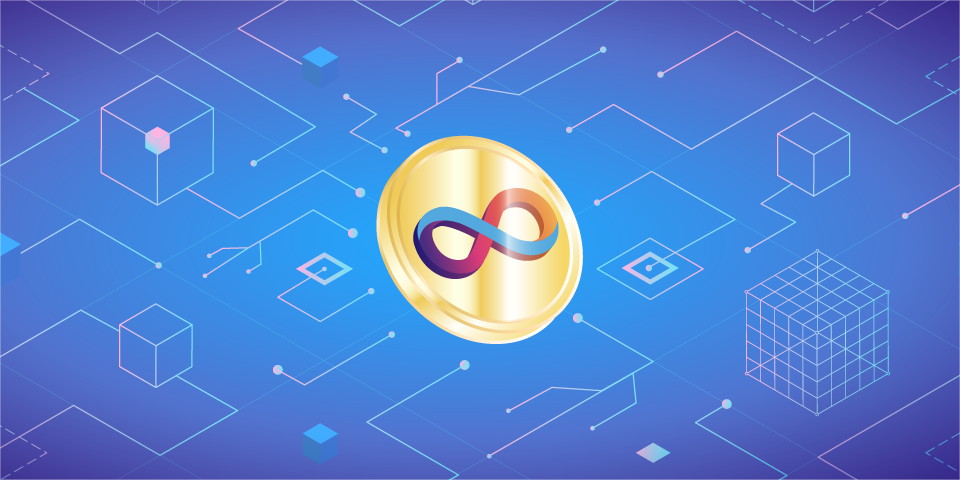
Author | Baize Research Institute
The ICP community has frequently seen the statement "the token is dead," which contains the disappointment, bitterness, and unwillingness of early supporters. Yes, the performance of Internet Computer in the two years since its mainnet launch has indeed been disappointing, making it unbearable for supporters who have staked their ICP for as long as 8 years from the beginning.
Now, the narrative of PoS-based token LSD has blossomed on mainstream public chains such as Ethereum (and Layer2), Cosmos, Solana, Polkadot, and Polygon. Ecosystems like Cosmos have pSTAKE, Stride, etc., Polkadot's ecosystem has Acala, Bifrost, etc., and Solana's ecosystem has Marinade, Jito, etc. Now, this trend has also reached Internet Computer, as holders can stake ICP in the governance system NNS to participate in network governance, providing a foundation and space for the development of LSD. The ICP ecosystem project to be discussed in this article is an LSD protocol—StakedICP.
Quick Review of LSD
LSD stands for "Liquid Staking Derivatives," which is the hottest track in the crypto industry this year. LSD is a type of liquid token that serves as a substitute for staked PoS tokens. Its essence is to release the liquidity of staked PoS tokens, allowing for staking rewards to be obtained in the event of redemption at any time, and it can also be used for trading, providing liquidity, lending, and obtaining additional DeFi income.
According to DefiLlama's data, the TVL of the LSD track is close to $22 billion, and it has been steadily at the forefront of DeFi since surpassing lending in early March this year.
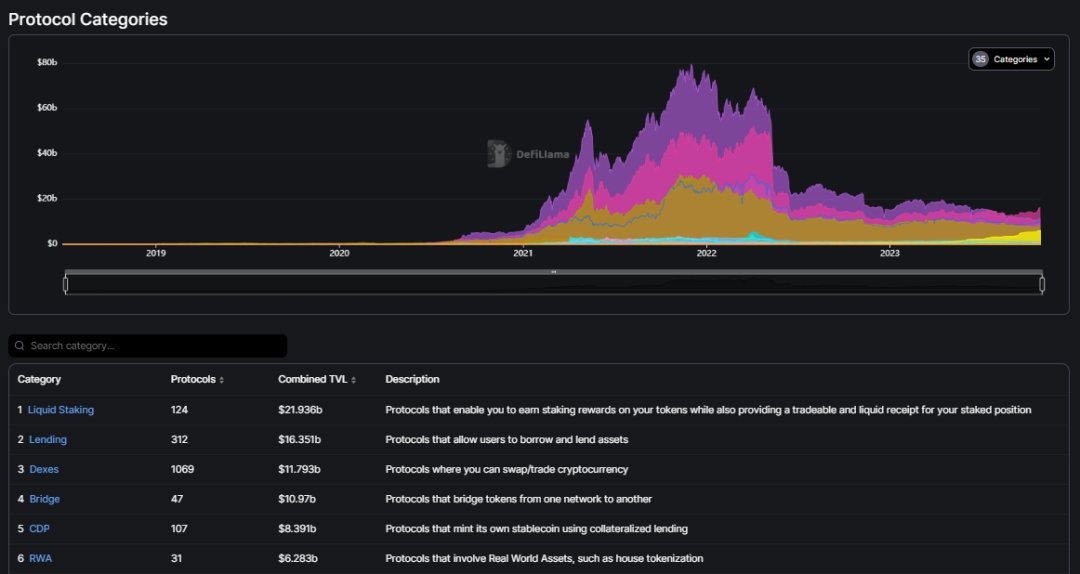
The LSD protocol not only enhances the security and stability of PoS blockchain networks but also maintains the flexibility for holders to manage their tokens, incentivizing more people to stake their tokens and participate in DeFi, ultimately benefiting all parties involved.
How Does StakedICP Release NNS Liquidity?
NNS (Network Nervous System) is the governance system of Internet Computer, responsible for regulating network upgrades, token economics, and adding or removing subnets. Everyone who stakes ICP becomes a "neuron" and participates in on-chain governance, and receives rewards for participating in governance. This is somewhat similar to Staking behavior in PoS. Currently, 249 million ICP are being staked, accounting for approximately 49% of the total supply, with a TVL of approximately $8.21 billion at current prices.
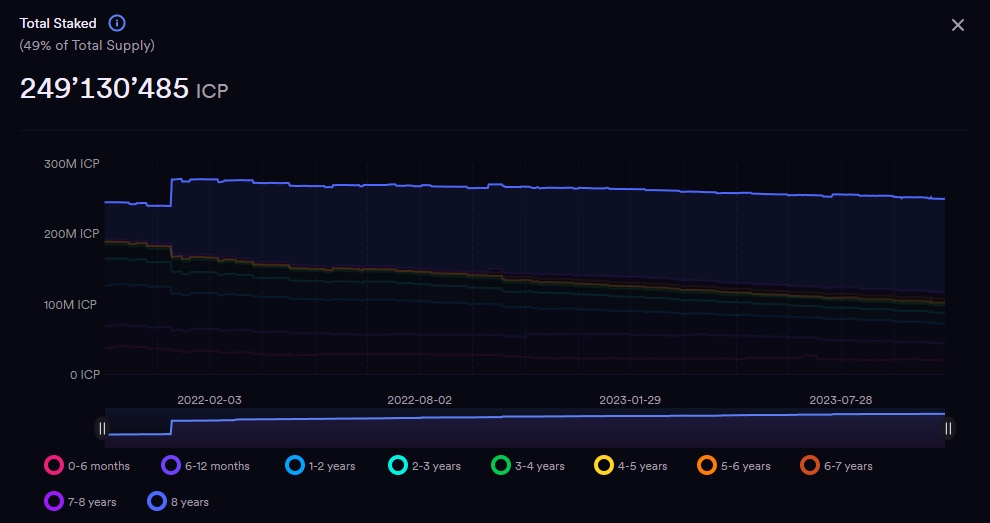
StakedICP is the first LSD protocol specifically designed for NNS neurons, allowing users to immediately receive the liquid token stICP after staking ICP on it. stICP is the only proof for users to redeem ICP and can capture the daily rewards generated by staked ICP. In short: holding the liquid stICP is equivalent to holding the staked ICP.
The protocol is currently in the testing phase, with only 123 users and 2600 staked ICP, with an APY of approximately 15.8%.
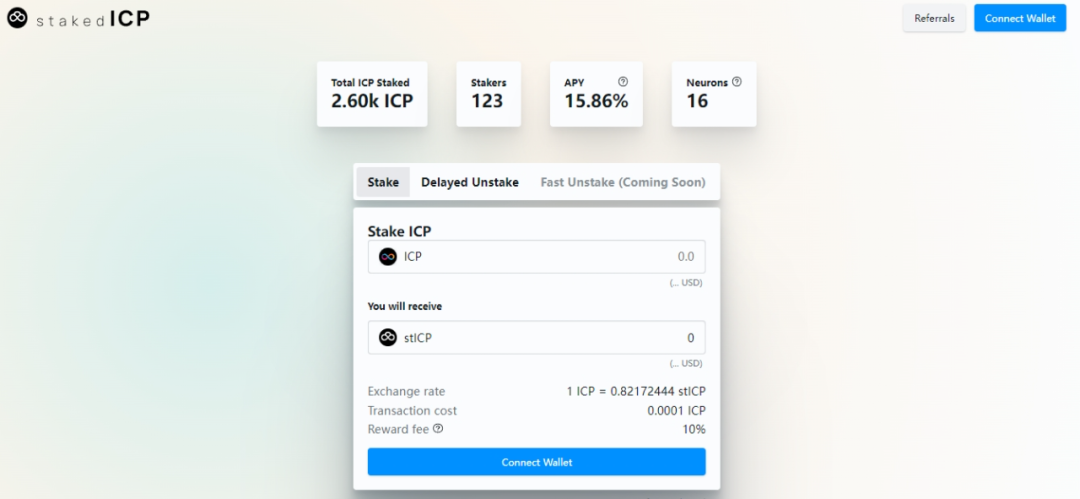
When users stake ICP using StakedICP, the ICP is staked on NNS through the protocol's neurons, and in return, they receive stICP tokens representing the staked ICP shares. In other words, holding stICP also entitles the holder to receive NNS rewards. How is this achieved?
Since the neurons of StakedICP continuously accumulate voting rewards on NNS, this means that 1 stICP > 1 ICP, and the value of stICP is always increasing compared to ICP.
For example, if I staked 10 ICP at the beginning when the ratio was 1 ICP = 1 stICP, I would receive 10 stICP.
Years later, due to the voting rewards received by the neurons on NNS, the total amount of ICP in the StakedICP neurons will continue to increase. Suppose 128 ICP has been staked in StakedICP, then the total ICP in the StakedICP neurons would be 160 ICP. Therefore, the value of 1 ICP would be 0.8 stICP (128/160); conversely, the value of 1 stICP would be 1.25 ICP (160/128).
At this point, if I choose to redeem 10 stICP for ICP, I would actually receive 12.5 ICP, which includes the NNS voting rewards.
Upon careful consideration, StakedICP can actually help increase the token staking rate of the IC chain to new heights.
Currently, the IC chain is developing its ecosystem around the project governance system SNS (Service Nervous System). In addition to staking on NNS, ICP can also be used to invest in projects in the SNS ecosystem. However, staked ICP cannot keep up with the new projects on SNS. Many ICP holders have given up staking as a result. In fact, StakedICP is a more flexible staking solution, allowing users to stake ICP to obtain and hold stICP, which can be redeemed for ICP at any time and then used to invest in SNS. It's a win-win situation for staking and investing in new projects.
In addition, when the IC chain's DeFi ecosystem develops, there will be more opportunities to provide additional use cases for stICP, which is LSDfi. At that time, stICP can be traded, and even used for lending and wealth management. While receiving staking rewards, users can also participate in DeFi to obtain additional income through liquidity. What will users do? Charge ahead? It can be foreseen that the staking rate of ICP will significantly increase, and the scale of the IC DeFi ecosystem will further grow.
How to Use StakedICP?
Staking
The staking function of StakedICP is currently available. Users can stake ICP on StakedICP to receive stICP.
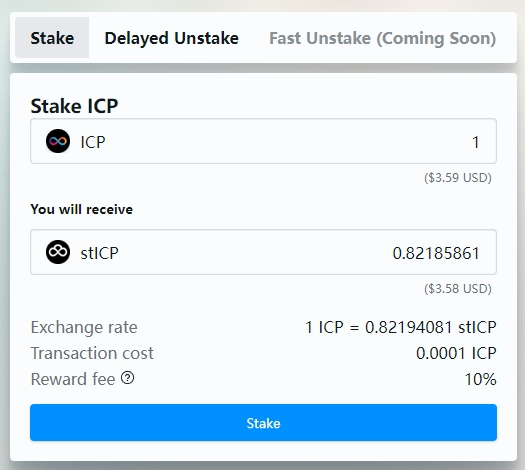
Redemption
Currently, StakedICP can only be Delayed Unstake. When users redeem ICP using this method, StakedICP will destroy stICP, identify the neurons to be split, and begin dissolution to complete the redemption as soon as possible. This may take some time (depending on the neurons). StakedICP has a total of 16 neurons, with staking durations ranging from 6 months, 1 year, 1.5 years to 8 years, to maintain the liquidity of the redemption function.
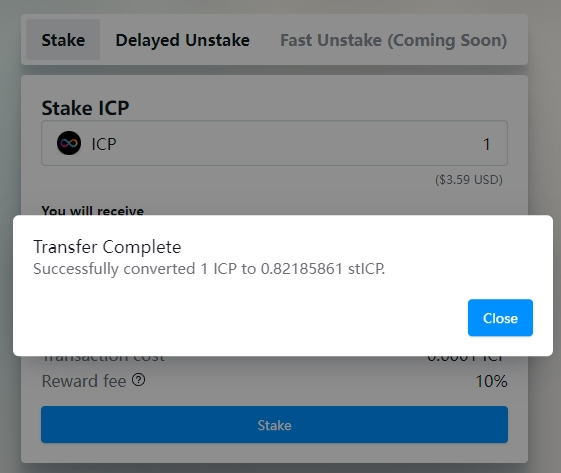
Another feature called Fast Unstake, which allows for quick unstaking, is currently under development. In short, StakedICP will create a one-sided liquidity pool for stICP/ICP, and LPs can add their ICP to the liquidity pool to earn trading fee rewards. When users want to redeem ICP using stICP, they only need to exchange in the pool.
Risks
StakedICP is still in the early stages of development and carries centralized risks. In the StakedICP v1 launched in 2022, for faster product testing, the neurons and smart contracts are directly controlled by the development team. In the StakedICP v2 version launched in May 2023, the 16 neurons used for staking ICP are no longer directly controlled by the development team but are controlled by the smart contract itself (voting follows the public neuron Synapse). However, due to the need for continued development, the smart contract is still managed by the development team. This drawback is expected to be resolved after the official launch of the final product, and StakedICP will be launched for public offering on SNS, with smart contract governance handed over to the community.
Founder of StakedICP: Eager to See LSDfi on IC
Recently, Baize Research Institute conducted a brief online interview with the founder of StakedICP, 0xAegir, to discuss his views on the future of StakedICP, LSD on the IC chain, and LSDfi.
Please introduce yourself to everyone.
I am 0xAegir, the founder of StakedICP, with 15 years of development experience.
What was your original intention in creating StakedICP?
Initially, I just wanted to earn the high staking rewards for staking ICP on NNS for 8 years without experiencing the pain of being locked in for 8 years. However, as StakedICP developed, I anticipated that assets like stICP, which can generate income and be circulated, would bring huge benefits to the IC ecosystem. So, I am really looking forward to seeing DeFi developers in the IC ecosystem build new use cases on top of stICP. stICP is just LSD, but the latest focus of the Crypto narrative is LSDfi.
Please explain the operating principle of StakedICP.
When you deposit ICP into StakedICP, you receive stICP. ICP is staked on NNS and grows over time through voting rewards. Simply by holding stICP, you can continuously earn increasing ICP rewards from voting. stICP is an "ICRC-1" token (similar to the Ethereum token standard ERC-20), so it can be integrated into DeFi for trading, selling, and use. Currently, you can use the "Delayed Unstake" feature to unstake, or use the newly developed "Fast Unstake" feature after a few months.
The following image shows the core features of StakedICP:
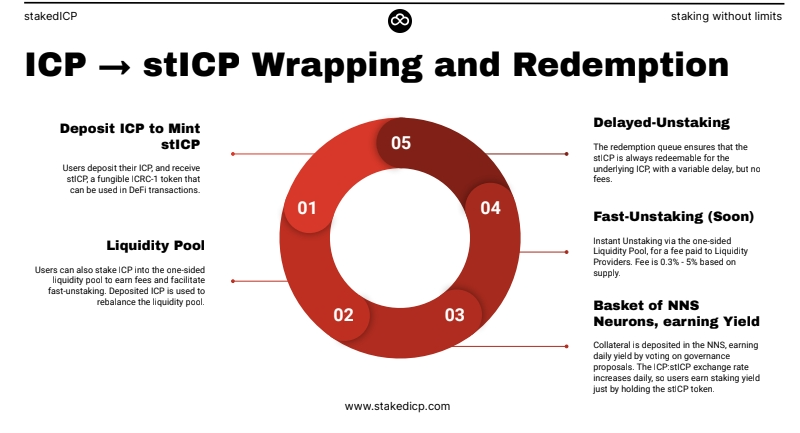
How do you currently manage the ICP locked in StakedICP?
The ICP staked in StakedICP is staked in a group of neurons on NNS. Last May, I launched the first smart contract that can host neurons on IC (https://github.com/AegirFinance/canister-owned-neuron). This means that the smart contract itself can control and fully own the neurons using IC's threshold ECDSA technology. If you're a nerd like me, that's pretty cool. Therefore, the neurons of StakedICP can only be controlled by the smart contract, and we are committed to transferring control of the smart contract to the community after the SNS launch.
Can you share the future development roadmap of StakedICP?

December 2023 - Completion of core protocol code
I am currently working hard to implement Fast Unstake, which provides great potential for widespread adoption in the IC community.
There are other features that need to be completed, but my goal is to complete all work by December.
January 2024 - Internal testing of Fast Unstake feature
April 2024 - Completion of code audit
In preparation for the SNS launch, once all StakedICP features pass testing, a formal code audit will be conducted.
June 2024 - Launch of SNS + Liquidity incentives
I hope that StakedICP will become an important part of the IC chain's DeFi ecosystem. The launch of the governance token STKD will enable the protocol to fully realize its potential and be governed directly by the community.
I am very interested in whether LSDfi can be implemented based on stICP, such as allowing stICP to be adopted by more DeFi lending projects, creating stablecoins based on stICP, and so on. Do you already have some ideas or plans?
I am also very interested in this. The LSDfi narrative has just begun, and I am eager to see what ideas people will come up with based on stICP.
Personally, I am most excited about things that encourage people to "double down," "reinvest," and develop the IC ecosystem. I am very interested in seeing someone combine stICP with SNS, even just a simple stICP → ICP exchange system, which would allow loyal ICP followers to not only passively earn income by holding stICP but also directly participate in public offerings on SNS (automatically converted to ICP) without having to choose.
Stablecoins are also an interesting dimension. I have had some promising conversations with people who want to build stablecoins based on stICP, but it is still in the early stages. Stay tuned.
Let's boldly imagine what StakedICP can bring to the IC chain and the ICP ecosystem when it grows large enough.
The most common ways to earn income for the ICP you hold on the IC chain are:
- NNS staking
- Investing in SNS projects
But these two methods cannot be carried out simultaneously.
Have you staked your ICP on NNS for 8 years, earning huge staking rewards, but being excluded from all other opportunities? Or have you saved ICP, waiting to invest in new projects on SNS?
I believe that stICP can provide a more flexible income alternative, helping people reinvest in new ways and truly commit to the ICP ecosystem. Secondly, starting from the previous question, I am really thinking seriously about the direction of LSDfi. Due to the unique technical attributes of the IC chain, such as reverse Gas and HTTPS outcalls, ICP has a huge opportunity to bring DeFi into the locked Web2 world. Some interesting LSDfi and RWA innovative services have already appeared on other chains, such as self-repayment loans and zero-interest loans, so how do we implement them? Or, how do we provide these new services to users around the world in a cheap, efficient, and easy way? I think everything is possible on the Internet Computer.
Note:
The above projects and views should not be considered as investment advice. DYOR. According to the notice issued by the central bank and other departments on "Further Preventing and Dealing with the Risks of Virtual Currency Trading Speculation," the content of this article is for information sharing only and does not promote or endorse any business and investment activities. Readers are strictly required to comply with local laws and regulations and not participate in any illegal financial activities.
Due to the revision of the public account, articles will no longer be published regularly.
If "Baize Research Institute" has been helpful to you,
please click "Like" and "Viewing."
免责声明:本文章仅代表作者个人观点,不代表本平台的立场和观点。本文章仅供信息分享,不构成对任何人的任何投资建议。用户与作者之间的任何争议,与本平台无关。如网页中刊载的文章或图片涉及侵权,请提供相关的权利证明和身份证明发送邮件到support@aicoin.com,本平台相关工作人员将会进行核查。




